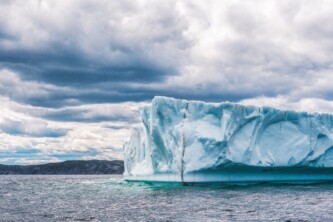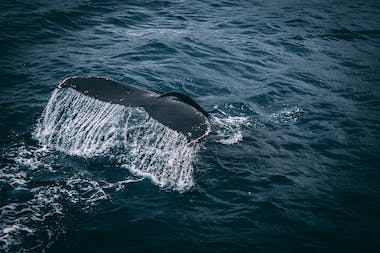The world’s biggest iceberg, called A23a, is finally moving after being stuck to the ocean floor for over 30 years. This huge iceberg broke away from the coast of Antarctica in 1986 but got stuck in the Weddell Sea, becoming an ice island. It’s about twice the size of Greater London, with an area of almost 4,000 square kilometers. In the past year, it has started drifting quickly and is now about to leave Antarctic waters.
A23a is not only big, but it’s also really thick. It’s about 400 meters thick, which is taller than the London Shard, which is only 310 meters tall. This iceberg was part of a group that broke away from the Filchner Ice Shelf in Antarctica. It broke away when there was a Soviet research station there, which shows how long ago it happened. Even though they sent a team to remove equipment from the research station, A23a stayed stuck to the ocean floor.
We’re not exactly sure why A23a is finally moving after almost 40 years. Some experts think it might be because of changes in water temperatures, while others think it was just a matter of time. Dr. Andrew Fleming, a scientist who studies remote sensing, saw the first movement of A23a in 2020. In the past few months, it has been pushed by winds and currents and is now passing the top of the Antarctic Peninsula.
Once A23a enters the Antarctic Circumpolar Current, it will be carried towards the South Atlantic on a path called “iceberg alley.” This is the same route that the famous explorer Sir Ernest Shackleton used in 1916 to escape from Antarctica after his ship got crushed by sea ice. If A23a gets stuck at South Georgia, it could mess up the normal routes that seals, penguins, and other seabirds take to find food. But it’s important to know that icebergs are actually important for the environment. As they melt, they release minerals that give nutrients to organisms at the bottom of the ocean food chain.
Scientists will keep a close eye on A23a and study how it affects the ecosystem around it. Even though there might be some risks, icebergs aren’t just dangerous objects. They also help with the life in the ocean.
Original news source: A23a: World’s biggest iceberg on the move after 30 years (BBC)
Listen
Slow
Normal
Fast
Group or Classroom Activities
Warm-up Activities:
– News Summary
Instructions: Divide the class into pairs or small groups. Give each group a few minutes to read the article together. Then, ask each group to summarize the main points of the article in a short news summary. They can take turns presenting their summaries to the class.
– Opinion Poll
Instructions: Divide the class into pairs or small groups. Ask each group to come up with a question related to the article, such as “Do you think it’s important to study icebergs?” or “Should we be concerned about the movement of A23a?” Have groups take turns asking their question to the class and recording the responses. Afterward, facilitate a discussion based on the different opinions shared.
– Vocabulary Pictionary
Instructions: Write a list of vocabulary words from the article on the board, such as “iceberg,” “Antarctica,” “ocean floor,” “remote sensing,” etc. Divide the class into two teams. Give each team a minute to choose one word from the list, without showing the other team. The chosen team then has to draw a picture representing the word, while the other team tries to guess what the word is. The team that guesses correctly gets a point. Repeat with different words until all have been guessed.
– Sketch It
Instructions: Pair up the students and give each pair a piece of paper and a pen or pencil. Ask one student from each pair to describe a specific part of the article, such as the size of A23a or the reasons why it might be moving. The other student must listen and sketch a visual representation of what they hear. Afterward, have pairs compare their sketches and discuss any differences or similarities.
– Think-Pair-Share
Instructions: Ask the students to think individually about the environmental impact of icebergs and the movement of A23a. After a few minutes, pair up the students and have them share their thoughts with each other. Then, bring the class back together and ask a few pairs to share their discussions with the whole group. Encourage students to ask questions or offer their own insights during the sharing session.
Comprehension Questions:
1. How long has the world’s biggest iceberg, A23a, been stuck to the ocean floor?
2. How big is A23a compared to Greater London?
3. How thick is A23a compared to the London Shard?
4. When did A23a break away from the Filchner Ice Shelf?
5. Why do some experts think A23a is finally moving after so many years?
6. Who saw the first movement of A23a in 2020?
7. What path will A23a take once it enters the Antarctic Circumpolar Current?
8. Why are icebergs important for the environment?
Go to answers ⇩
Listen and Fill in the Gaps:
The world’s biggest iceberg, called A23a, is finally moving after being stuck to the ocean floor for over 30 (1)______. This huge iceberg broke away from the coast of Antarctica in 1986 but got stuck in the Weddell Sea, (2)______ an ice island. It’s about twice the size of Greater London, with an area of almost 4,000 square (3)______. In the past year, it has started (4)______ quickly and is now about to leave Antarctic waters.
A23a is not only big, but it’s also really thick. It’s about 400 meters thick, which is taller than the London Shard, which is only 310 meters tall. This iceberg was part of a group that broke away from the Filchner Ice Shelf in Antarctica. It broke away when there was a Soviet research station there, which shows how long ago it happened. Even though they sent a team to remove equipment from the research station, A23a (5)______ stuck to the (6)______ floor.
We’re not exactly sure why A23a is finally moving after almost 40 years. Some experts (7)______ it might be because of changes in water (8)______, while others think it was just a matter of time. Dr. Andrew Fleming, a scientist who studies remote sensing, saw the first movement of A23a in 2020. In the past few months, it has been pushed by winds and currents and is now passing the top of the (9)______ Peninsula.
Once A23a enters the Antarctic Circumpolar (10)______, it will be carried towards the (11)______ Atlantic on a path called “iceberg alley.” This is the same route that the (12)______ explorer Sir Ernest Shackleton used in 1916 to escape from Antarctica after his ship got crushed by sea ice. If A23a gets stuck at South Georgia, it could mess up the normal routes that seals, (13)______, and other seabirds take to find food. But it’s important to know that icebergs are actually important for the environment. As they melt, they release minerals that give nutrients to organisms at the bottom of the ocean food (14)______.
Scientists will keep a close eye on A23a and (15)______ how it affects the ecosystem around it. Even though there might be some risks, icebergs aren’t just dangerous (16)______. They also help with the life in the ocean.
Go to answers ⇩
Discussion Questions:
Students can ask a partner these questions, or discuss them as a group.
1. What is an iceberg?
2. How would you feel if you saw a huge iceberg like A23a in person?
3. Do you think it’s strange that A23a was stuck to the ocean floor for over 30 years? Why or why not?
4. Have you ever seen an iceberg before? If so, where and what was it like?
5. What do you think caused A23a to finally start moving after so many years?
6. How do you think the movement of A23a might affect the ecosystem in the ocean?
7. Do you think it’s important for scientists to study the effects of A23a on the environment? Why or why not?
8. What do you think would happen if A23a gets stuck at South Georgia?
9. How do you think icebergs help with the life in the ocean?
10. Do you think it’s risky for A23a to be drifting towards the South Atlantic? Why or why not?
11. If you were a scientist studying A23a, what would you want to learn about it?
12. Have you ever heard of Sir Ernest Shackleton? If so, what do you know about him?
13. How do you think the melting of icebergs could affect the food chain in the ocean?
14. Do you think it’s important for people to be aware of the movement of icebergs? Why or why not?
15. If you had the chance, would you like to visit Antarctica and see icebergs up close? Why or why not?
Individual Activities
Vocabulary Meanings:
Match each word to its meaning.
Words:
1. iceberg
2. stuck
3. thick
4. temperatures
5. movement
6. currents
7. route
8. ecosystem
Meanings:
(a) The level of hot or cold in the air or water
(b) Unable to move or become unstuck
(c) Having a large width or depth
(d) The act of changing position or location
(e) The community of living organisms in a particular environment
(f) The path or course taken to reach a destination
(g) A huge block of ice floating in the ocean
(h) The steady flow of water in a particular direction
Go to answers ⇩
Multiple Choice Questions:
1. How long has the world’s biggest iceberg, A23a, been stuck to the ocean floor?
(a) Over 20 years
(b) Over 40 years
(c) Over 50 years
(d) Over 30 years
2. What is the size of A23a compared to Greater London?
(a) Twice the size
(b) Half the size
(c) The same size
(d) Three times the size
3. How thick is A23a?
(a) About 200 meters
(b) About 600 meters
(c) About 400 meters
(d) About 100 meters
4. When did A23a break away from the Filchner Ice Shelf?
(a) 1996
(b) 1986
(c) 2006
(d) 2016
5. What could be a possible reason for A23a finally moving?
(a) Changes in water temperatures
(b) Changes in wind patterns
(c) Changes in ocean currents
(d) Changes in iceberg size
6. What is the path that A23a will take once it enters the Antarctic Circumpolar Current?
(a) Iceberg highway
(b) Iceberg alley
(c) Iceberg route
(d) Iceberg lane
7. Who used the same route as A23a to escape from Antarctica in 1916?
(a) Sir Francis Drake
(b) Captain James Cook
(c) Sir Ernest Shackleton
(d) Christopher Columbus
8. What do icebergs release as they melt?
(a) Oxygen
(b) Carbon dioxide
(c) Nitrogen
(d) Minerals
Go to answers ⇩
True or False Questions:
1. A23a is not incredibly thick, measuring about 400 meters, taller than the London Shard.
2. Once A23a enters the Antarctic Circumpolar Current, it will follow the same path as the famous explorer Sir Ernest Shackleton in 1916.
3. The reason for A23a finally moving after all these years is still uncertain, with some experts suggesting changes in water temperatures as a possible cause.
4. Dr. Andrew Fleming, a remote sensing scientist, did not observe the first movement of A23a in 2020.
5. A23a did not break away from the coast of Antarctica in 1986 and become an ice island in the Weddell Sea.
6. The world’s largest iceberg, known as A23a, has been stuck to the ocean floor for over 30 years.
7. It is about twice the size of Greater London, with an area of almost 4,000 square kilometers.
8. It did not break away from the Filchner Ice Shelf when there was a Soviet research station present.
Go to answers ⇩
Write a Summary:
Write a summary of this news article in two sentences.
Check your writing now with the best free AI for English writing!
Writing Questions:
Answer the following questions. Write as much as you can for each answer.
Check your answers with our free English writing assistant!
1. How long has the world’s biggest iceberg, A23a, been stuck in the ocean floor?
2. How big is A23a compared to Greater London?
3. Why did A23a break away from the Filchner Ice Shelf in Antarctica?
4. What are some possible reasons why A23a is finally moving after almost 40 years?
5. What could happen if A23a gets stuck at South Georgia?
Answers
Comprehension Question Answers:
1. How long has the world’s biggest iceberg, A23a, been stuck to the ocean floor?
A23a has been stuck to the ocean floor for over 30 years.
2. How big is A23a compared to Greater London?
A23a is about twice the size of Greater London.
3. How thick is A23a compared to the London Shard?
A23a is about 400 meters thick, which is taller than the London Shard.
4. When did A23a break away from the Filchner Ice Shelf?
A23a broke away from the Filchner Ice Shelf in 1986.
5. Why do some experts think A23a is finally moving after so many years?
Some experts think A23a might be moving due to changes in water temperatures or simply because it was a matter of time.
6. Who saw the first movement of A23a in 2020?
Dr. Andrew Fleming, a scientist who studies remote sensing, saw the first movement of A23a in 2020.
7. What path will A23a take once it enters the Antarctic Circumpolar Current?
Once A23a enters the Antarctic Circumpolar Current, it will be carried towards the South Atlantic on a path called “iceberg alley.”
8. Why are icebergs important for the environment?
Icebergs are important for the environment because as they melt, they release minerals that give nutrients to organisms at the bottom of the ocean food chain.
Go back to questions ⇧
Listen and Fill in the Gaps Answers:
(1) years
(2) becoming
(3) kilometers
(4) drifting
(5) stayed
(6) ocean
(7) think
(8) temperatures
(9) Antarctic
(10) Current
(11) South
(12) famous
(13) penguins
(14) chain
(15) study
(16) objects
Go back to questions ⇧
Vocabulary Meanings Answers:
1. iceberg
Answer: (g) A huge block of ice floating in the ocean
2. stuck
Answer: (b) Unable to move or become unstuck
3. thick
Answer: (c) Having a large width or depth
4. temperatures
Answer: (a) The level of hot or cold in the air or water
5. movement
Answer: (d) The act of changing position or location
6. currents
Answer: (h) The steady flow of water in a particular direction
7. route
Answer: (f) The path or course taken to reach a destination
8. ecosystem
Answer: (e) The community of living organisms in a particular environment
Go back to questions ⇧
Multiple Choice Answers:
1. How long has the world’s biggest iceberg, A23a, been stuck to the ocean floor?
Answer: (d) Over 30 years
2. What is the size of A23a compared to Greater London?
Answer: (a) Twice the size
3. How thick is A23a?
Answer: (c) About 400 meters
4. When did A23a break away from the Filchner Ice Shelf?
Answer: (b) 1986
5. What could be a possible reason for A23a finally moving?
Answer: (a) Changes in water temperatures
6. What is the path that A23a will take once it enters the Antarctic Circumpolar Current?
Answer: (b) Iceberg alley
7. Who used the same route as A23a to escape from Antarctica in 1916?
Answer: (c) Sir Ernest Shackleton
8. What do icebergs release as they melt?
Answer: (d) Minerals
Go back to questions ⇧
True or False Answers:
1. A23a is not incredibly thick, measuring about 400 meters, taller than the London Shard. (Answer: False)
2. Once A23a enters the Antarctic Circumpolar Current, it will follow the same path as the famous explorer Sir Ernest Shackleton in 1916. (Answer: True)
3. The reason for A23a finally moving after all these years is still uncertain, with some experts suggesting changes in water temperatures as a possible cause. (Answer: True)
4. Dr. Andrew Fleming, a remote sensing scientist, did not observe the first movement of A23a in 2020. (Answer: False)
5. A23a did not break away from the coast of Antarctica in 1986 and become an ice island in the Weddell Sea. (Answer: False)
6. The world’s largest iceberg, known as A23a, has been stuck to the ocean floor for over 30 years. (Answer: True)
7. It is about twice the size of Greater London, with an area of almost 4,000 square kilometers. (Answer: True)
8. It did not break away from the Filchner Ice Shelf when there was a Soviet research station present. (Answer: False)
Go back to questions ⇧













